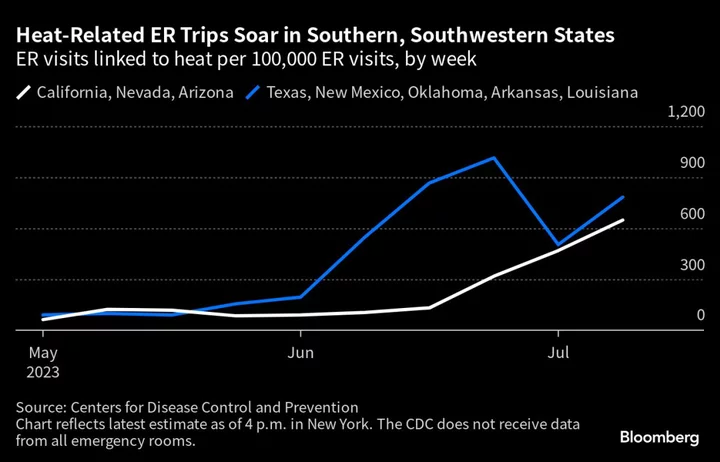Heat-related illnesses have spiked as the US bakes in a record-hot summer, forcing some hospitals to call in more staff to treat a surge in patients.
The proportion of emergency-room visits linked to heat skyrocketed in Texas and surrounding states starting in June, according to Centers for Disease Control and Prevention data, with some weeks surpassing levels seen last year. Rates soared in other parts of the country, including the Southwest, in late June and July. Doctors in Arizona and Texas said it’s the worst summer they’ve experienced, with a higher number of patients coming in and some needing treatment for severe conditions like heat stroke, when high body temperatures can damage vital organs and sometimes lead to death.
Temperatures have set monthly and all-time records around the country in the past month, spiking well above 100F (38C) in many places. There’s little chance of relief soon: Most of the US has a high chance of warmer-than-normal temperatures through Aug. 3, according to the Climate Prediction Center.
In Phoenix, where temperatures were on track to hit 110 or higher for a 22nd consecutive day on Friday, the Valleywise Health system has called in extra staff to handle its highest volume of patients since the pandemic.
Summertime heated-related illnesses are “not an uncommon problem,” in Phoenix, said Valleywise Chief Clinical Officer Michael White, “but the number of patients that we’re seeing now with heat exposures has risen.”
At least 18 people died of heat-related causes this year through July 15 in Maricopa County, which includes Phoenix, the county public health department said in a weekly report. A further 69 deaths were under investigation.
At Texas Health Presbyterian Hospital Plano, the emergency department had to implement a surge plan to bring in more staff, said Andrew Morris, chair of emergency medicine. Heat has contributed, he said, as well as higher rates of trauma cases in the summer. A return to hospitals and emergency rooms after patients had shied away during the pandemic is also contributing, he said.
The Texas Health system’s 20 emergency rooms saw 181 patients complaining of heat stroke and heat exhaustion in June, the most for that month in records going back to 2019.
Many patients have relatively mild illnesses, doctors said, including heat exhaustion and rashes from sun exposure. Others have had extreme cases of heat stroke, and may be given IV fluids or sometimes wrapped in specially designed bags filled with ice.
At Tampa General Hospital, several heat-related cases have been particularly concerning, said emergency-medicine physician Jason Wilson. Some patients had temperatures as high as 107, while others had third-degree burns from lying in the hot sun, which can happen when heat stroke alters a victim’s mental state.
Doctors sometimes take extreme measures in these cases, including implanting tubes that move cold water into a patient’s body, said Wilson, chief of the University of South Florida’s emergency medicine division, which is affiliated with the hospital.
It will be some time before the summer’s full toll is known, but it’s likely to be significant. The US saw 3,066 heat-related deaths from 2018 to 2020, according to the CDC.
While Wilson hasn’t seen the number of patients rise above past years, he said doctors are concerned and keeping an eye on the situation.
It’s “like a shark bite summer,” he said. “You kind of have to wait and see where things fall out.”
--With assistance from Brian K. Sullivan.

